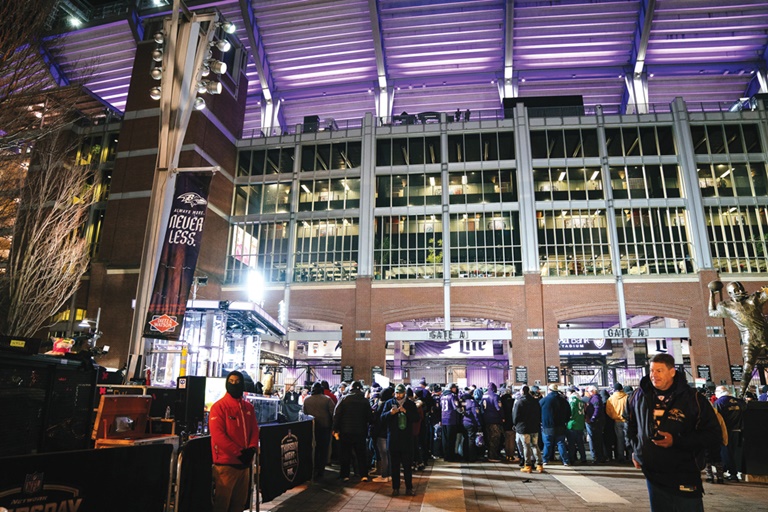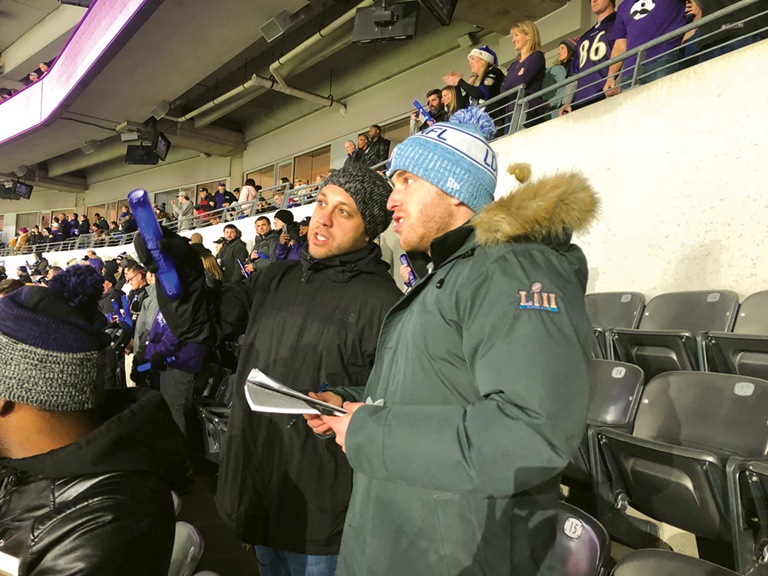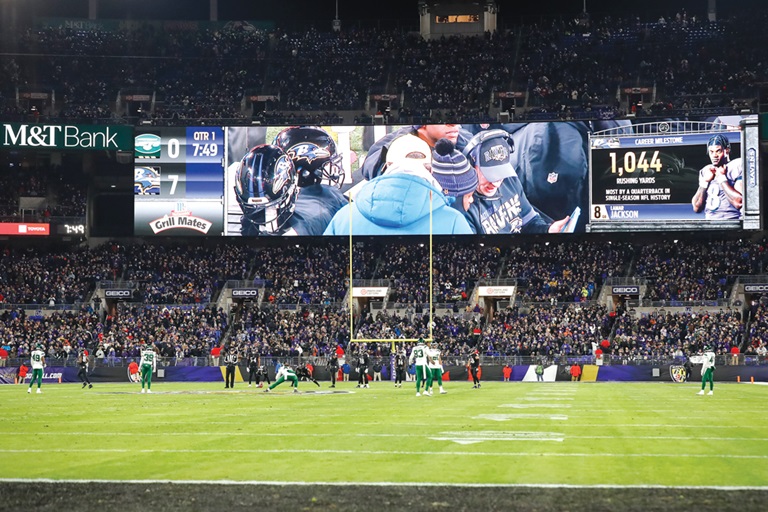Secret shoppers track everything that happens at a stadium on game day to better understand — and enhance — the fan experience.
With eight and a half minutes remaining in the first quarter of a “Thursday Night Football” matchup between the Baltimore Ravens and the New York Jets at M&T Bank Stadium on Dec. 12, Ravens quarterback Lamar Jackson took the snap and ran 5 yards to the New York 6-yard line. The late-arriving crowd gave a slightly louder than usual cheer, recognizing that the league’s probable MVP had just broken Michael Vick’s 13-year-old record for most rushing yards by a quarterback in a season.
However, there was no mention of the record on either of the 200-by-36-foot video boards that dominate the back of the stadium’s end zones. Nor was there an announcement over the public address system. And that was just the way the NFL — and a couple of league employees sitting in Section 206 — wanted it.
Jackson’s achievement — he finished the season with 1,206 rushing yards — would not be noted until after Baltimore capped that drive with a touchdown, when the additional crowd noise would not adversely affect the Ravens offense. That’s the depth of thought the league expects stadium game-day operations staffs to have, and it’s just what Glenn Hyams and Tim Tubito of the League Observation Program were expecting as they took detailed notes on everything happening in and around M&T Bank Stadium on a bitterly cold evening.
Hyams’ day-to-day role is as the NFL’s manager of club business development, and Tubito is the league’s director of event presentation and content. Tonight they are known as secret shoppers, and they are performing a task that takes place, usually unseen, at all 256 regular-season games: observe every detail of a stadium’s off-field operations, and file a report for the team in question.
Those on assignment often come from the NFL’s New York headquarters, where this year 93 people from a variety of departments volunteered for the role, or sometimes from another NFL team not playing in that particular game. They are given regular tickets, usually for a club seat, as Hyams and Tubito had been on this night. Executives for the home team have been expecting their arrival, but individual staffers in retail, parking and other such areas don’t know that they are being graded.
The league’s Club Business Development division aims to evaluate everything, but the clubs also ask for feedback on specific programs, usually new efforts or known challenges. On this night, I have been invited to tag along with Hyams and Tubito. In all, the two have acted as observers at 51 games over the past four years and would each do so eight times this season, though this is the first time they’ve worked together. The game doesn’t kickoff until 8:20 p.m., but our day will start much sooner.
■ 4:40 p.m. — I enter the lobby at the Renaissance Harborplace Hotel, where Hyams and Tubito are waiting for me. We discuss the plan for the evening and what they’ll be looking for. There’s one twist coming that will light up social media, and Hyams and Tubito are already expecting it.
■ 5:18 p.m. — We’re less than a mile from the stadium, but Tubito drives his personal SUV that he had driven down from New York. After the game he will drive the roughly 200 miles back so he can be home for his young daughter’s birthday party the next day. Driving also allows us to test out the parking lots. It’s a late-arriving crowd because it’s a work day, which makes parking easier for us but will later raise the stakes for staffers trying to manage the traffic.
■ 5:44 p.m. — We arrive at the Ravens Walk, the outdoor experiential marketing area between M&T Bank Stadium and Oriole Park at Camden Yards. On a night in which temperatures drop into the high 20s, some problems are obvious: “I think these heaters aren’t working,” Hyams says, looking into the DiamondBack Resorts activation. A few minutes later, they see that the one employee at the Verizon tent was on his phone, not engaging with passersby.
A bright spot: The friendly worker at the bag check booth clearly articulates the stadium’s bag policy and answers Hyams’ questions accurately. Hyams takes his name so he can give him a positive review. Elsewhere: the Bud Light concert stage is too close to activations that also have amplified sound, causing a jarring mix of noise. Also, the Under Armour tent is expertly produced, and the Maryland Zoo earns high praise for offering fans a photo opp with real ravens.

■ 6:10 p.m. — Just outside of the Hamburg Street gate, three men approach us and identify themselves as Baltimore plainclothes police. They are suspicious of our note-taking, photography and close attention to the surroundings. We each prove our identities and are free to move on.
■ 6:15 p.m. — Hyams asks an employee for an explanation on mobile ticketing. She wrongly says fans can use a screenshot of a ticket for entry. Another worker is unsure of the answer and describes the clothing of someone who might. Ravens officials want feedback on worker knowledge, which Hyams and Tubito later report is good overall. “We’ve got 2,500 people here, for all those people to be on the same page is a huge challenge,” said Roy Sommerhof, the team’s senior vice president of stadium operations.
■ 6:25 p.m. — We line up to enter the stadium and have to wait about five minutes, mostly because the gates are just opening. Mobile ticketing works fine, and employees make sure every fan receives a purple Styrofoam light stick, to be used during the pregame player introductions.
■ 6:33 p.m. — While surveying the official Ravens store, Hyams notes its cramped space that makes movement difficult, even when in line. He praises the labeling on clothing racks, but knows from a previous site visit that Cleveland’s First Energy Stadium has rafter signage that makes it easy to find the appropriate clothes in a very crowded area.
■ 6:45 p.m. — The guest assistant at the the elevator to the club level is in an exceptionally good mood, handing out high fives. “You don’t get that at a lot of stadiums,” Hyams says, noting her name. A few minutes earlier, a worker informs us how to get to the club section, and then chases us down when he sees that we are going the wrong way. Both employees were noted for praise in the final report.
■ 6:50 p.m. — We buy food in the club level. The Ravens lowered food prices in 2018, and a large Chicken Philly sandwich and a water costs me $14. Tubito praises the digital signage above a main bar that displays photos of fans at the game who have used the hashtag #RavensFlock on social media. The staff is friendly and helpful. There are also some unexpected surprises: One worker serving me the sandwich goes off message and tells me she is a Washington Redskins fan.
■ 7:27 p.m. — We enter our section. The seating bowl is still nearly empty as the teams warm up. Tubito says the pregame warmups are an important time for the producers who operate the live audio-visual presentation. “This is when your diehards are in their seats,” he says. “It’s a chance to educate fans and to pump up your own players.” He’d know, having previously been in charge of the Jets’ game-day entertainment and venue presentation.
At times, the stadium video crew focuses on a player, and then shows his stats next to his live image on the two main video boards that hang in both end zones. Jackson has dedicated music playing when he takes the field, helping hype up one of the biggest stars in the league.
■ 8:02 p.m. — Less than 20 minutes until game time, the stands still seems to be at least 85% empty. Tubito and Hyams predict a late rush. “If it’s still like this at 10 minutes out, that’s not good,” Hyams says.
■ 8:05 p.m. — It’s “Champions Day,” on which every high school football state championship team in Maryland is introduced on the field. Earlier Hyams and Tubito had praised a large sign by the field entrance outside the stadium, which clearly told several hundred participants where they need to report for a timely introduction. “This is a good way to connect with the community,” Hyams says. As game time approaches, those high schoolers create a tunnel for the player introductions that stretches from the corner of one end zone all the way to midfield. It goes smoothly.
■ 8:10 p.m. — As expected, most fans take their seats as the kickoff nears. Ushering people into their seats in time for pregame ceremonies and the start of the game is a persistent challenge at stadiums. The Ravens believe the player-introduction traditions started by legendary linebacker Ray Lewis in the team’s early days have trained fans to consider it important.
After the dazzling light and pyrotechnic show that is the player introductions, Tubito is impressed. “That’s as good as it gets,” he says. “Every part of the building was integrated into the show, and everything was so cohesive.” At one point, the stadium lights go down, giving fans the chance to participate by waving their giveaway glowstick. Tubito also praises the purple LED lighting on the Ravens band’s drums as an example of the attention to detail. Video boards show multiple angles of the players taking the field.
By game time, the team says 50,000 people are in the stadium. That’s up from the 10,000 who had arrived an hour before kickoff, while about 15,000 more arrived in the first hour after the game started. That still leaves about 6,000 no shows, despite the listed attendance of 70,545 in a 71,008-capacity stadium. Even with the late-arriving crowd, Ravens officials said the ingress speed met expectations.

■ 8:21 p.m. — The Ravens have a new experiment at this game, a “mixed reality” feature on their main video boards: an animated raven is superimposed over live video of the stadium itself, creating the appearance that a bird the size of a commercial plane has flown into the stadium, done a lap and perched on the west goalposts. This is the twist Hyams and Tubito were expecting, but their muted response matches that of the crowd. The raven returns later and, says Tubito, “It seemed like they found better ways to utilize it, that combined with fans getting used to it made it a real positive.”
■ 8:22 p.m. — The game starts. For the next three hours, Hyams and Tubito observe all of the sound and images used to enhance the game, and watch how the fans around them respond to video and public-address prompts, which entertainment features work, which don’t and why.
■ 8:36 p.m. — After the Ravens open the scoring with Mark Ingram’s 6-yard touchdown run, Tubito and Hyams note that replay footage from NFL Network looks “stretched” on the rectangular video board at the back of the west end zone. Also, they note the lack of audio on the highlights, which made it so some fans didn’t realize what was being shown. Later, their report will read, “Consider implementing the radio call over the highlights.”
■ 8:42 p.m. — The Ravens devote a media timeout to the “Hometown Heroes” content feature on the big video board. “The footage was clearly framed and having the hero close off with a ‘Go Ravens, Beat the Jets’ shout was a nice touch,” the report would later say.
■ 8:44 p.m. — Just before New York’s Sam Ficken attempts a 49-yard field goal, the stadium video board flashes a sign: All fans win a free six-piece McNuggets order from McDonald’s when opponents miss a field goal. Then Baltimore’s Patrick Ricard blocks the kick. The main video board and the ring boards light up in McDonald’s red and yellow: Free McNuggets! Even better, another positive review from Hyams and Tubito.
■ 9:33 p.m. — With the Ravens leading 21-7 just before halftime, the Jets are driving into Baltimore territory and video boards flash: “Visitors want quiet. Please respond accordingly.” In their report, Hyams and Tubito will call that “Very unique and effective fan prompts that always seem to rile up the crowd.” The crowd has another reason to cheer when safety Chuck Clark intercepts a Sam Darnold pass.
■ 9:44 p.m. — On such a cold night, the official halftime show — including the All-Star Stunt Dogs — doesn’t keep many people in their seats. Most go to the concourse to get out of the wind. M&T Bank Stadium isn’t alone among NFL venues in that the seats are still mostly empty when play resumes.
■ 10:16 p.m. — With the Ravens leading comfortably, Hyams notes the shift in tone from the game entertainment: “They front-load a lot of the sponsor obligations, and just play to the crowd in the second half.” This means less programming and more long music breaks and casual crowd shots.
■ 10:53 p.m. — The video board shows Lyft-branded content explaining how to find rideshares after the game. “Rideshare pickup is something no team has really solved yet,” Hyams says.
■ 11:25 p.m. — The Ravens win, 42-21. A stadium employee hands out pre-printed Baltimore Sun covers celebrating the team’s second straight AFC North title. Hyams praises the move because many fans miss having the physical memento a ticket stub used to provide. Hyams and I walk back to our hotels.
■ Monday, Dec. 16: Although it wasn’t due until later in the week, Hyams and Tubito submit their written report to the Ravens. It has two parts, one on stadium operations and a 12-page section on game entertainment.
■ Thursday, Dec. 19: Hyams and Tubito join a conference call with Ravens officials to go over their reports. Not all of the feedback is accepted. For instance, the team decides to not follow Hyams’ suggestion to add public-address voiceover to a “sizzling stats” feature, because they’ve had fan feedback about too much PA. But another note in the report was immediately acted upon. They noted that fans really engaged with the TV timeout feature “Pass 4 Cash,” but couldn’t see the action well because of a high, wide camera angle. Two weeks later against the Steelers, the Ravens switched to hand-held cameras on the field for the feature.
This article originally appeared at sportsbusinessdaily.com by Ben Fischer on 1/13/20.

